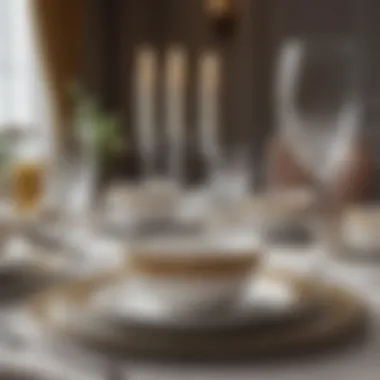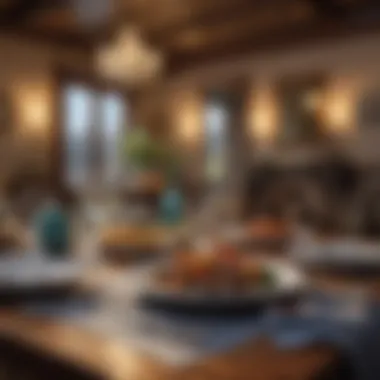Mastering Place Setting: A Guide to Elegant Dining


Intro
Setting a table is an art often overlooked yet critical in social dining situations. The arrangement of utensils, glassware, and plates can significantly influence both the aesthetic and practical elements of a meal. Understanding the nuances of this practice enhances one’s appreciation of dining, whether it is a casual gathering or a formal event.
Historical Context of Place Setting
The tradition of setting tables dates back centuries, steeped in history and cultural significance. Different epochs and societies developed unique place setting practices based on available resources, culinary customs, and social norms. By understanding this historical context, one learns significant aspects that influence today’s table setups.
In many cultures, the table setting symbolizes hospitality, respect, and social hierarchy. The French, for example, have refined the art of table arrangement, emphasizing elegance through precise placements of fine china and elaborate cutlery.
“A well-set table contributes to the overall experience, establishing the mood and inviting conversation.”
Practical Applications
Knowing how to lay a table helps avoid silliness during meals. Recognizing distinction between formal and informal settings can guide appropriate selection of items and layout.
Formal Place Settings
In a formal dinner setting, one expects a stringent adherence to protocol. Typically, one would use several pieces of cutlery and glassware, aligned geometrically around the plates. Generally, the following items are included:
- Dinner plate – Centered and used as the main area for food.
- Salad Plate – Placed on top of the dinner plate, often removed before the main course.
- Cutlery – Forks to the left, knives and spoons to the right.
- Glassware – Positioned above the knives; usually includes a water glass, wine glasses, and perhaps a champagne flute.
Informal Place Settings
Conversely, informal settings can be more relaxed yet still elegant. This style often uses fewer utensils. You might find:
- Dinner Plate – The primary piece, often housing the main dish.
- Utensils – A fork and knife are typically used, sometimes complemented with a dessert spoon.
- Glass of Water – A simple addition to accommodate guest comfort during the meal.
Cultural Considerations
Cultural contexts greatly influence how dining occurs, extending even to the arrangement of place settings. Certain cultures may prefer no meat or specific utensils to reflect their beliefs or traditions. For instance, some Eastern cultures may blend utensils and vegtables based on their communal eating style.
Successfully incorporating cultural nuances into place setting shows sophistication. Sliding in simple geometries or color palettes exhibits settlements that respect traditions without luxuries.
Summary
Gaining awareness of place setting placement goes well beyond arrangement; it communicates care for guests and understanding of lasting customs. Proper understanding ensures high I.Q. social connections and improvements in personal dining experiences. As one learns to set the table, one also cultivates a deeper appreciation for food and shared moments of connection that accompany eating.
Prolusion to Place Settings
Place settings are fundamental to dining, enveloping essential practices steeped in tradition and functionality. Understanding how to properly arrange plates, utensils, and glassware holds significant importance in various contexts—be it dining at home or within more formal atmospheres. This introductory section serves not just to explain the components of a place setting, but also to underscore its relevance in enhancing the dining experience.
The arrangement of place settings reflects cultural identity, etiquette, and even personal preferences. Etiquette varies whether it’s a casual family meal or a formal gathering. Each setup an tells its own story, contributing to the overall ambience of the dining experience. Recognizing this distinction is crucial for those wanting to tailor their gatherings impressively.
Historical Background
Historically, the methods of place setting evolving through time, diverging vastly depending on cultural significance and socio-economic conditions. In the Middle Ages, serving utensils were rare, with dining methods often involving communal plates. As societies advanced, use of separate utensils became more widespread, touching on aspects of personal hygiene and individual dining experiences.
Notably, essential shifts occurred in the Renaissance era, where dining became a symbol of refinement and class. Social standings became increasingly tied to proper dining conduct, including meticulously arranged settings. Forbidden practices in this regard marked those who did not adhere to such expected norms. Hence, these historical lineages establishing the modern place setting still bear influence in the way meals are served today.
Purpose of Place Settings
The purpose of a place setting transcends mere arrangement of cutlery. It promotes both functional and aesthetic elements that facilitate an engaging dining experience. Placing items correctly assures functionality; for instance, proper utensil placement allows easier access during a meal, minimizing the need to reach excessively or disrupt the table’s flow.
Moreover, the aesthetic appeal of a well-set table cannot be underestimated. A thoughtfully arranged place setting elevates the visual experience of dining as much as the meal itself. When one learns the nuances, integrating texture, color, and spatial arrangements according to the context greatly enhances guests' comfort and enjoyment.
Proper place setting fosters good dining etiquette and courteous behaviour, which produce memorable meals and experiences for all involved.


This section attempts to lay the groundwork so that readers may appreciate the subsequent discussions on components and different customs found across cultural dining settings. A thorough discussion on the significance of place settings instils a sense of propriety and speaks directly to enhancing one’s hosting capabilities.
Components of a Place Setting
Understanding the components of a place setting is pivotal to establishing a refined dining atmosphere. The way each item is positioned not only enhances the table's aesthetics but also facilitates functionality during a meal. These elements promote a seamless interaction for guests and hosts alike.
Dinnerware
Dinnerware includes plates, bowls, and many essential items used to serve and consume food. The type of dinnerware selected often depends on the formality of the occasion. For expansive meals, consider utilizing various plate sizes—appetizer plates, dinner plates, and dessert dishes. Materials of dinnerware vary widely, which also informs choices. Ceramic or porcelain is usually suitable for formal meals, not just for durability but significant visual appeal as well. It’s important to arrange plates in a manner that reflects the chronological order of the dishes served, giving an idea of what’s next. This foresight aids guests in better understanding and enjoying their dining experience. Ultimately, thoughtful selection promotes a balance between function and design.
Flatware
Flatware, generally consisting of knives, forks, and spoons, is significant in the setting. Properly aligning silverware hints at the meal's course while conveying to guests the mannerisms expected for their meal. In formal settings, the order of placement dictates how each piece functions as meals progress. For instance, the outermost fork will be reserved for the first course. Counterintuitively, cleanliness and shine became pivotal; fingerprints taint their presence. Materials also play a role; stainless steel flatware is steadfast and elevates the dining experience, yet wooden or bamboo options signify a casual approach. Educating oneself about flatware nuances directly retains the enjoyment of dining traditions.
Glassware
Glassware encompasses water glasses, wine glasses, and more. Selecting appropriate glassware alters not only the presentation but the ambiance as well. Different drinks influence the type of glass; for example, a red wine glass varies from that of a white wine glass due to the differing aeration needs of the beverages. When placing glassware, it generally ensues a pattern reflecting the meal; drinks for each course should seamlessly flow together. An important aspect often overlooked relates to brightness and transparency. Streaks or smudges can disadvantage a meal significantly from around leaks or even reservations. A radiant display enchance the whole setting
Linen and Textiles
Linen and textiles, often regarded less critically, possess noteworthy functions in a plate setting. Items like tablecloths and napkins have essential purposes—protecting the table and adding elegance to the setting. A clean, well-pressed tablecloth laid underneath branches the impression of professionalism and intent. Selecting colours that suit the meal can either complement or starkly contrast other settings, controlling the theme yet never overwhelming it. Ensuring your napkin is prepared in an appealing and practical way promotes ease of use while transitioning between meal courses. The role of linens goes beyond aesthetics; practical integration enhances the overall dining vista, securing an impression free of judgment or confusion.
Types of Place Settings
Understanding the various types of place settings is essential for achieving the desired atmosphere for any dining experience. Each type serves a distinct purpose, influenced by the context and formality of the event. The three main categories—formal, informal, and casual—provide flexibility for different dining scenarios, addressing aesthetics, functionality, and even social etiquette. By differentiating between these settings, one enhances not only the practical aspects of dining but also the overall experience.
Formal Place Setting
Definition and Overview
A formal place setting is characterized by a precise arrangement of dinnerware, flatware, and glassware. It usually comes into play during significant occasions, like weddings or formal dinners. This setting stands out for its meticulous presentation and attention to detail. One key characteristic is the positioning of utensils and plates, requiring adherence to specific protocols. The formal setting is beneficial because it elevates the social formality of the event, enhancing the dining atmosphere. However, its complexity can be intimidating for those unfamiliar with it.
Common Usage Scenarios
Common usage scenarios for formal place settings include charity galas, official banquets, or extravagant holiday gatherings. Such occasions benefit significantly from the elegance and sophistication these settings imbue. The distinct organization reinforces tradition and decorum during these significant events. A unique feature of formal place settings is the inclusion of various forks, knives, and perhaps a soup spoon, making it a rather complete arrangement for multi-course meals. The downside, however, lurks in its rigidity; not all guests may feel comfortable within its boundaries.
Informal Place Setting
Characteristics
Informal place settings are more relaxed and adaptable than formal ones. They have fewer rules and allow for personal expression while focusing on functionality over aesthetics. The key characteristic here is the simplicity, with fewer items than a formal setting, tailored to everyday gatherings or dinner parties among friends. This informal style is a popular choice because of its comfort and ease of setup. Its uniqueness lies in the creative flexibility it offers, though poorly planned setups can detract from the overall experience.
Appropriate Settings
Appropriate settings for informal place settings include family dinners and friendly get-togethers. This type fits well in relaxed environments, encouraging conversation and interaction. The ease of setting an informal arrangement contributes to its appeal, making it beneficial for scenarios focusing on social connection. A key advantage is how it promotes accommodating various dining preferences. Nevertheless, an oversimplified setting risks appearing casual, so a balanced approach is essential.
Casual Place Setting
Explanation and Context
Casual place settings are designed for everyday use, aimed at routine family meals or casual dining experiences. They generally include just the basics—plates, cutlery, and simple glassware without excessive decor. This simplicity appeals to those looking for straightforward dining solutions. One unique feature is its practicality, enabling users to focus on food and company. The downside, however, is that lack of attention to detail may reduce the overall dining experience.
Everyday Dining Formats
Everyday dining formats typically involve casual place settings, with adaptations based on family size or meal type. These adaptable arrangements capture ordinary moments, integrating ease and functionality into daily routines. A casual setup suits well when done correctly, fostering comfort without altering the dining experience significantly. Lightweight materials, like melamine, rank similarly in common purchasing necessity. However, there is a risk of proceedings becoming monotonous if not regularly updated.
Cultural Variations in Place Settings
Cultural variations play a significant role in place setting practices. They reflect broader social norms, traditions, and values. Understanding these variations helps individuals appreciate different dining experiences and engage in respectful etiquette.


Proper placement involves nuances dictated by regional customs that must be considered when dining. Acknowledging these cultural facets elevates decorum in any occasion. Guests feel a sense of reconnaissance and warmth when differences in etiquette are respected. This understanding explores the myriad ways either informal or formal settings particulary can vary across cultures.
Western Table Etiquette
In Western cultures, table etiquette focuses on structured arrangements. The typical setup includes items placed symmetrically, aligning cutlery, glassware, and dinnerware. For instance, the fork is usually to the left of the plate and the knife to the right, garnering expectations of precision and order.
Key aspects include:
- The use of multiple utensils to accommodate courses.
- Proper glassware often mirrors the drink served; a wine glass for red or white, with clearer glasses for water and other drinks.
- Napkins are folded and placed per the host's discretion; often either on the dinnerware or to the left.
Adhering to these guidelines establishes a level of decorum that is appreciated in many settings, from celebratory dinners to casual gatherings.
Eastern Table Etiquette
Eastern dining traditions, particularly in Asian cultures, reflect deep-rooted customs that may differ greatly from their Western counterparts. The arrangement of items often melds with food served in shared formats. Meals generally commence communal plating first, emphasizing shared experiences over individual portions.
Basic principles include:
- Chopsticks are essential, and their handling indicates respect. Each diner may have individual utensils for serving to prevent direct contact with communal items.
- Bowed alteration forms convey respect. The level of bow is often connected to hierarchy and role.
- Placement focuses on harmony in appearances and balances on symmetry.
These variances enhance the dining experience through factors like sociality and shared connection, creating dynamic interactions that are foundational to culturally rich gatherings.
Understanding these cultural distinctions in place settings is not merely about aesthetics; it is about respect and creating experience tailored for inclusivity.
Grasping these cultural elements isn't just a checklist. It's an enriching approach towards enhancing social interactions that matter and making dining an art of togetherness.
Importance of Proper Placement
The placement of table settings is not mere decor. It is a significant aspect that can influence dining experiences profoundly. Proper placement emphasizes not only the aesthetics and overall theme of the meal but also the functionality that enhances interaction. A balanced set of placements can provide an air of hospitality, making guests feel welcomed and comfortable.
Setting a table correctly establishes an organized environment, facilitating easier access to various dining elements. Equally important, it reflects respect and consideration for guests, fostering warm interactions. On a practical level, well-structured place settings can minimize disruption during a meal, thus maintaining flow where conversation and nourishment are equally valued. To neglect such placement is to overlook an integral part of dining rituals.
Aesthetics and Symmetry
Aesthetics play a key role in place settings. A well-presented table creates a visually inviting surface that can delight guests even before the meal begins. This symmetry in design is important. It creates balance and encourages relaxation, making it easier to enjoy food and company.
Consider the principles of design:
- Visual appeal: Ensures every piece complements the other, including dinnerware, flatware, and glassware.
- Balance: Utilizes centerpieces or attractive placements without overcrowding.
- Proportions: Maintaining proportion to create a harmonious layout; larger dishes placed at the back bring coherence.
This meticulous attention touches each aspect of the dining table, generating an impression that lingers beyond the last course of the meal.
Functionality and Accessibility
While beauty is essential, so too is functionality. An effectively set table must allow each guest to access their utensils and items easily. The fundamental rule here is that every piece should serve a purpose in aiding the dining experience.
Here are key considerations:
- Ease of reach: Place utensils where they can be accessed conveniently without trouble.
- Space constraints: Ensure materials chosen are proportionate to the table size, conveying seamless accessibility.
- Course flow: Anticipate the progression of meals, aligning placement to facilitate transitions between courses.
Functionality ensures that guests’ movements are fluid and natural, enabling a relaxed atmosphere throughout the dining experience.
Proper positioning of elements cultivates an environment ripe for enjoyable social interactions.
Mastering both aesthetics and practical placement stands as a pathway for elevating the art of dining, inviting genuine appreciation of the culinary experience.
Creating a Balanced Place Setting


Creating a balanced place setting is vital for enhancing the dining experience. It encompasses thoughtful arrangement, color selection, and texture proportioning. By paying attention to these factors, one elevates not only the aesthetic appeal but also the functionality of the dining table.
Spatial Arrangement
The arrangement of items on the table dictates its visual flow and usability. Placing each component purposefully ensures guests can access what they need without obstruction. A well-structured arrangement usually includes the following principles:
- Alignment with Dining Flow: Forks on the left and knives on the right match natural movements, allowing diners to reach for utensils with ease.
- Use of Space: Items should not clashing with one another. Allow ample room for food and drink, maintaining a balance between clutter and utility.
- Table Centerpiece: This should be low enough to encourage conversation across the table. Overly tall arrangements can become barriers.
Taking these elements into account prepares the stage for a pleasant dining experience, blending aesthetics with practicality.
Color Coordination
Color coordination is much more than a visual concern; it creates a harmonious atmosphere. Appropriate color themes can influence moods, making the dining experience feel more inviting or elegant. Here are a few considerations:
- Complementary Colors: Choose colors that complement the dinnerware and décor. For instance, a dark blue plate pairs well with white linens, creating a striking contrast.
- Seasonal Themes: Leverage seasonal palettes. Light colors and florals infuse summer meals with vibrance, whereas earthy tones suit autumn gatherings.
- Intensity Levels: Balance bold colors with neutral elements. If the flatware has a vibrant hue, you need soft contrasts to prevent overwhelming the table.
When chosen correctly, colors in both the tableware and decorations can significantly enhance ambience.
Texture Balance
Texture appears to the sense of touch as well as sight. A table representative of varied textures offers more interest and depth. Achieving texture balance involves combining different materials such as:
- Contrasting Feelings: A smooth tablecloth against textured dinnerware can create a delightful optical contrast. Plastic plates may evoke casualness, while crystal glassware expresses a formal setting.
- Layering Textures: Gift the stratification of heavy linens and light napkins a try. Use placemats to add dimension without overshadowing the ensemble.
- Stackable and Functional Elements: Having stackable elements can contribute multi-dimensional ethics without taking excessive space.
Ultimately, achieving the proper balance of texture avoids monotony and engages the senses, adapting well to youthful meals or elegant dinners.
A perfectly balanced place setting is a blend of spatial arrangement, color coordination, and texture balance. Each aspect seeks to enhance both the aesthetic and practical functions of dining, redefining how setting evolves a gathering.
Common Mistakes in Place Setting
Understanding the art of place setting goes beyond knowing the components and types; it also requires awareness of common errors that can easily detract from an effective dining experience. These mistakes can undermine the overall intent of the meal, affecting how guests perceive the table as well as the atmosphere surrounding the dining occasion. One key element of various dining experiences is the presentation, which has direct implications on how the food and the setting are appreciated. Recognizing and avoiding common mistakes promotes a refined dining etiquette, fostering seamless interactions among diners, enhancing aesthetics, and ensuring efficiency during the meal.
Overcrowding the Table
One significant error in place settings is overcrowding the table. In an eagerness to showcase an array of flatware and dinnerware, many fail to consider the importance of balance and space. Placing too many items on the table can lead to confusion, making it difficult for diners to navigate through the utensils and glassware. Guests may feel cramped, contradicting the very essence of dining, which is to enjoy comfort while consuming food. Therefore, it is advisable to minimize complexity by using essential items for the settings and avoiding excessive placements.
Recommendations for Avoiding Overcrowding:
- Limit the Use of Utensils: Use only necessary knives, forks, and spoons based on the menu.
- Utilize Space Wisely: Ensure ample space between settings to allow for easy movement.
- Consider the Aesthetic: Keep the table visually appealing while eliminating excess components.
Overcrowding compromises enjoyment and defeats the purpose of a well-prepared dining environment.
Neglecting Cultural Differences
Another prevalent mistake is neglecting cultural differences in table settings. Diverse cultures around the world have specific conventions dictating how tables ought to be arranged and what items should be used. Ignoring these variances can disrupt the dining experience for guests who are used to certain traditions or Practices, potentially creating discomfort. To respect cultural nuances, diners should take time to familiarize themselves with the likenesses and unique variances present in the etiquette of different dining styles.
Tips to Address Cultural Differences:
- Research: Understand the cultural background of the guests attending the meal.
- Adapt Settings: Modify placings according to regional and cultural dining norms.
- Communicate: Be open to discussions about preferences or practices during the meal.
When properly considered, cultural understanding enriches interactions, promotes inclusivity, and elevates the quality of the dining event. By avoiding overcrowding and acknowledging diverse customs, one can lay the foundation for a broader appreciation of global dining practices.
Epilogue
Recap of Key Points
- Historical Signficance: Place settings convey a rich history and social importance which varies by culture and occasion.
- Components and Layers: Familiarity with elements such as dinnerware, flatware, glassware, and linens is critical to optimal presentation.
- Types of Settings: Knowing the distinctions between formal, informal, and casual arrangements ensures appropriateness in various situations.
- Cultural Perspectives: Recognizing variations in table etiquette around the world enhances respect and appreciation for other customs.
- Common Mistakes: Awareness of pitfalls, such as overcrowding and neglecting cultural variations, allows for better execution of place settings.
Future Considerations
As dining experiences evolve, keeping abreast of new trends is key. Future place setting arrangements may consider:
- Sustainability: An increasing focus on eco-friendly materials may change how settings are configured and received.
- Personalization: Tailoring place settings to individual preferences might become more common as informal dining grows in popularity.
- Virtual Dining Etiquette: In a world with rising online social interactions, guidance on virtual dining arrangements will likely gain importance.
Place settings do more than serving food; they transform the meal into a acknowledged ritual that respects the diner and the dining culture.



